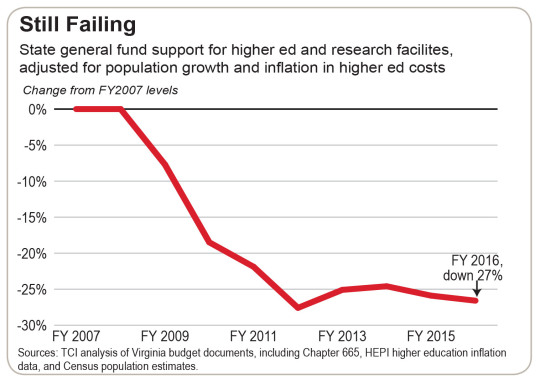August 25, 2015
Taking Stock: Gathering Facts before Budget Season
Governor McAuliffe and Secretary of Finance Brown will give two important speeches to the general assembly’s Joint Money Committee Thursday morning. The event will give Virginians further insight into the state of the commonwealth and the governor’s priorities as his administration prepares Virginia’s next two-year budget, which will take effect July 1, 2016 and go through June 30, 2018.
As policymakers turn their attention to that budget, we’ve released a pair of reports that provide information on the key challenges and choices facing Virginia.
An Opportunity for Progress makes several predictions about the next two-year budget. Assuming a strong finish to the current budget year, reasonable revenue growth over the next budget period, and cautious estimates about cost increases, Virginia should bring in $3.4 billion more over the next two years than the last two years. But current policy requires $2.67 billion of that to be used just to maintain Virginia’s low, current levels of support for health care and education. Including carry-over, unspent dollars from the budgets of various agencies, that leaves around $750 million.
The recent $553 million budget surplus announcement back in June, and that $750 million forecast for available general fund revenue makes the situation look rosy, but years of cuts and flat funding have left essential services starved of adequate resources. In fiscal years 2017 and 2018, $750 million represents a potential start, but is nowhere near enough to fix Virginia’s schools, bring class sizes back down to reasonable levels, rein in the shift of college costs onto students, provide reasonable care for seriously disabled adults, and fully unwind recession-era cuts and gimmicks.

All is Not Well chronicles just what that underinvestment – now $4 billion below pre-recession levels after adjusting for inflation and population growth – has meant for meeting the needs of the commonwealth, and how that has had real impacts on families and communities across the state.
State direct aid for public education will be down 14 percent this year compared to 2007 after adjusting for inflation and swelling enrollment. As a result, class sizes are swelling and school boards around the state have been facing tough choices about what to cut. It would cost $1.1 billion above the $825 million in estimated technical increases to restore K-12 per-pupil direct aid to more reasonable levels. That’s far more than the expected $750 million in available revenue.
In addition, this year’s support for colleges, universities, and research centers will be down $650 million since the recession after adjusting for higher education costs and growing enrollment. That’s helped push the colleges to increase tuition and fees, resulting in students and their families taking on a far higher share of college costs than in the past. It would cost $1.2 billion more than the $150 million increase that is included in the forecast in order to return per-pupil higher education funding to fiscal year 2007 levels assuming level enrollment and adjusting for inflation. Again, that’s far more than the expected $750 million in available revenue.
Virginia’s Medicaid waiver program needs $40 million more than is included in the forecast to provide decent services for individuals with intellectual and developmental disabilities and comply with the terms of Virginia’s settlement with the Department of Justice. And there are $650 million in necessary minor increases in funding for state parks, social services, and other areas just to keep those services from eroding further.

Budget decisions in the six years since the recession have significantly eroded the quality of essential public services in Virginia, and students, families, and the economy can’t afford to keep suffering the consequences.
Thursday’s meeting should offer additional insights into how much additional money Virginia should have over the next two-and-a-half years and the governor’s priorities. While rising revenue is cause for optimism, policy makers need to take pause to consider Virginia’s shrinking commitment to K-12 schools, public colleges, and everything else we know builds a strong economy.
Our commonwealth can afford nothing less.
–Aaron Williams, Research Assistant
